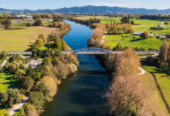Good Local Media serves the Waipā district with its main centres of Te Awamutu and Cambridge.
In Māori terms this district comes under the mana of King Tuheitia Potatau Te Wherowhero VII both as Māori King, but also as Te Arikinui of the Tainui Waka confederation of tribes.
The recent faux pas by the New Zealand High Commissioner to the United Kingdom Phil Goff requires some thought on our part as to both why it caused an offence and also why it needed to be addressed immediately by the King’s spokesperson.
Media reporting of the warmth of the relationship between King Tuheitia Potatau Te Wherowhero VII and King Charles III reflects a long-standing cordiality in the relationship of the Māori King Movement and the British Monarchy which has escaped the attention of much of mainstream New Zealand and, it would appear, to many amongst our elected and appointed leadership.
Before his consecraton as the first Māori King in 1858, Potatau Te Wherowhero signed ‘He Whakaputanga o te Rangatiratanga o Nu Tireni’ known in English as ‘The Declaration of Independence of the United Tribes of New Zealand’.
This declared that sovereign power and authority in the land resided with ‘Te Whakaminenga’- the Confederation of the United Tribes – and that no foreigners could make laws in ‘Nu Tireni’ – New Zealand. Through the British resident and consulate representative James Busby the Whakaminenga sought and were granted the protection of King William IV against threats to their ‘mana/tino rangatiratanga’ from outside. In return they promised to protect British subjects in Nu Tireni. They thanked him also for acknowledging their flag.
Following King William IV’s passing in 1837, his niece, Victoria was crowned Queen in 1838, two years before the signing of Te Tiriti o Waitangi – The Treaty of Waitangi – the second article of which promised Māori ‘tino rangatiratanga’.
With the ensuing explosion of new colonists from Europe, Great Britain in particular, this promise was being threatened. Māori ‘mana/tino rangatiratanga’ their independence as a sovereign power – promised in both the 1835 declaration and the 1840 treaty – was being undermined by successive Colonial Governments. In 1858 Potatau Te Wherowhero was consecrated as Māori King with the explicit injunction on him from the Tūwharetoa paramount chief Te Heuheu that he and Queen Victoria be as one in realising the aspirations for the people of this land, Māori, Pākehā, and all others.
Through each successive generation, to all intents and purposes this seeking of unity with the Kīngitanga and the British Monarchy has continued. The successor to King Pōtatau, King Tāwhiao, led the Kīngitanga in resisting the colonial breaches of Te Tiriti in the invasion of his Waikato homelands, taking refuge with his Ngāti Maniapoto relations in Te Nehenehenui, later termed the King Country.
King Tāwhiao travelled to England with the intent of meeting Queen Victoria face-to-face. This audience however was stymied by the Colonial Government’s missive not to allow the audience to take place. Tawhiao returned home asserting. ‘I haere Māori atu, ka hoki Māori mai’ – I went and have returned with my Māori mana intact.
His son and successor King Mahuta accepted the offer of a seat on the Legislative Council in 1898. With King Edward VII crowned in 1902, the positivity in that relationship was further asserted in the Ngāti Maniapoto Kawenata of 1903, pledging an allegiance to both kings, echoing the call from Te Heuheu in 1863 that the Māori and British sovereigns would work as one to realise the aspirations for all the people of this land.
His son and successor King Te Rata was granted an audience in 1914 with King Edward’s son and successor King George V. However the declaration of war with Gemany took a precedence in everyone’s attention.
Following the abdication of Edward VIII in 1936, his brother was crowned King George VI leading up to the turbulent years of World War II. King Te Rata’s son and successor King Korokī similarly led his kingdom through that tumultuous period following the passing of his father in 1933.
With the death of King George VI in 1952, in 1953 his successor Queen Elizabeth II visited New Zealand. She paid an unscheduled, unprecedented, unsanctioned visit to Turangawaewae Marae, the centre of the Kīngitanga. There she was escorted on to the marae and amongst the people by then Princess Piki, later Te Arikinui Dame Te Atairangikaahu, to the delight of Māori who had gathered there to wave at the Queen’s cavalcade as the official schedule had her merely driving past
The cordiality of this relationship continued with each visit Queen Elizabeth paid to New Zealand, and Te Arikinui Te Atairangikaahu’s visits to England.
It culminated in a hitherto unprecedented event. A moment in the history which all indigenous people world-wide continue to acknowledge and celebrate today. It will never be forgotten amongst the Māori people particularly by those of the region served by this newspaper.
Queen Eliabeth, the reigning monarch of a colonising nation signed in her own hand her personal apology to the Waikato people as a colonised people. This event was witnessed by the leadership of that people and the Government installed by the colonisers. Noably this apology took place at Turangawaewae the physical and spiritual heart and centre of the Waikato people and of the Māori King Movement, the Kingitanga.
Successive Governments up to that time had not only ignored He Whakaputanga and Te Tiriti, but had deliberately and systematically broken the promises in them.
King Tūheitia’s spokesperson Archdeacon Ngira Symonds had no choice but to point out to the High Commissioner and those present his faux pas.
The warmth of the relationship enjoyed by Queen Elizabeth and Te Arikinui Te Atairangikaahu continues with their successors. King Charles III’s personal invitation to King Tuheitia Potatau Te Wherowhero VII to attend his Coronation at Westminster Abbey and media reports of the two clearly enjoying each other’s company reflect this.
Following Queen Elizbeth’s royal apology in 1995 there is a growing warmth and a welcome attention to the relationship between successive governments, central and local, and Māori. However there is much yet to do as the High Commissioner’s gaffe shows.
As one witness at the coronation asserted on live television, let’s give King Charles a fair go. Let’s give the New Zealand government a fair go also in how they and their officials honour the special relationship they have with Māori.










